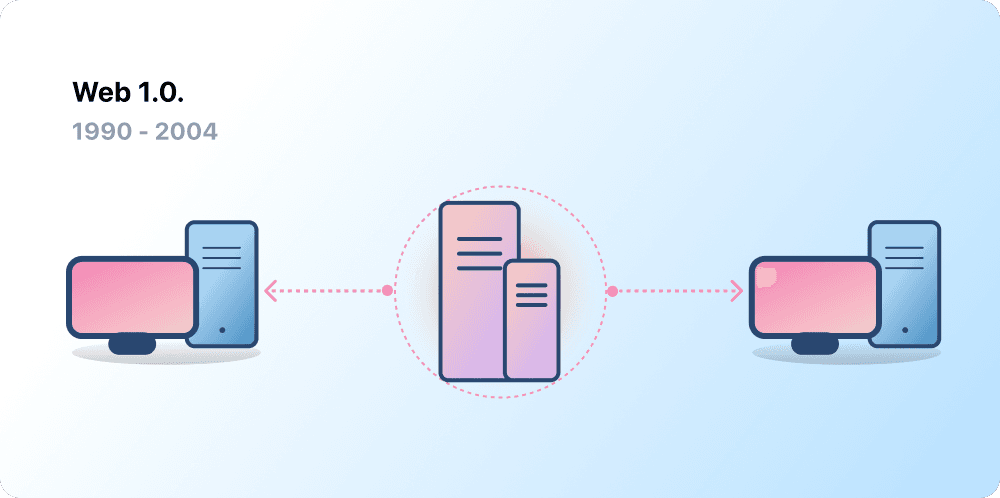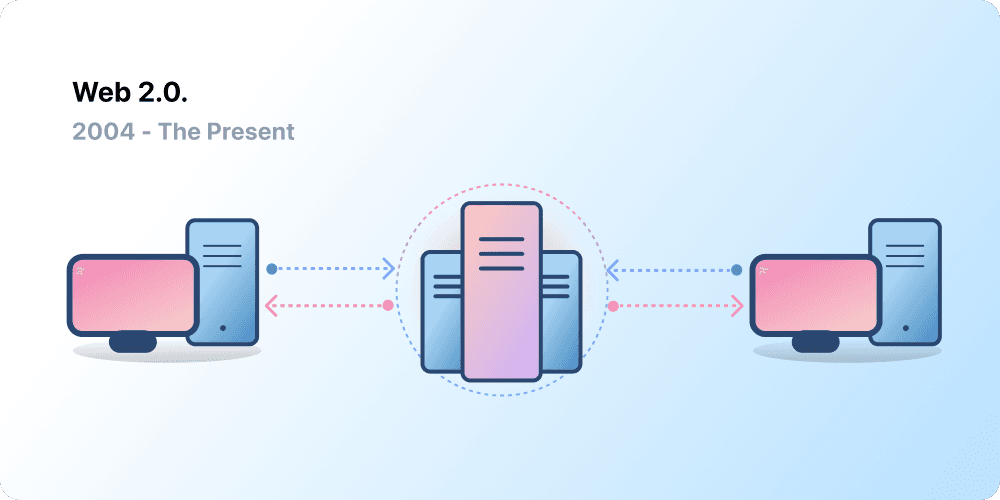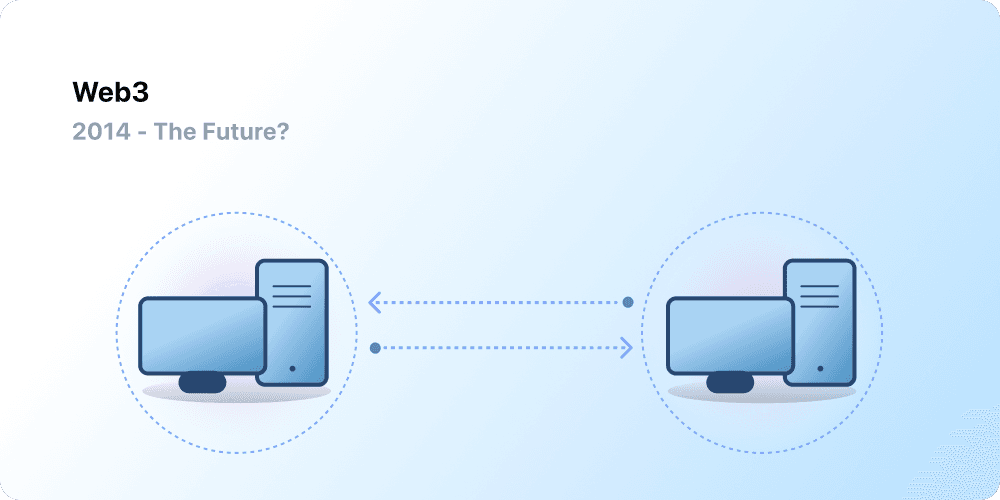مقدمة عن الإصدار الثالث من الويب Web3
ساعدت المركزية على تعريف بلايين من الناس على شبكة الإنترنت العالمية وأوجدت البنية التحتية المستقرة والقوية التي تقوم عليها. وفي نفس الوقت، أصبح لمجموعة من المؤسسات المركزية سيطرة على مساحه كبيرة من شبكه الإنترنت العالمية، بحيث تستطيع اتخاذ قرارات انفرادية بشأن ما يُسمح و لا يُسمح به.
الإصدار الثالث من الويب Web3 يوفر الحل لهذه المعضلة. فبدلاً من احتكار الويب بواسطة شركات التكنولوجيا الضخمة، الإصدار الثالث من الويب Web3 يتبنى اللامركزية ويتم بناؤه وتشغيله وامتلاكه من قِبل مستخدميه. وبذلك يعطي الإصدار الثالث من الويب Web3 السلطة للأفراد بدلاً من الشركات. قبل التحدث عن الإصدار الثالث من الويب Web3، دعونا نستكشف كيف وصلنا إلى هنا.
بداية شبكه الويب
معظم الناس يعتقدون أن شبكه الويب هي دعامه مستمرة من دعامات الحياة الحديثة-فقد اختُرعت وظلت قائمة منذ ذلك الوقت. ولكن شبكه الويب التي يعرفها معظمنا اليوم تختلف تمامًا عما كان متصورًا في الأصل. ولفهم هذا بشكل أفضل، قد يكون من المفيد أن نقسم تاريخ الويب القصير إلى مرحلتين واسعتي النطاق-وهما الويب 1.0 والويب 2.0.
الويب 1.0: قراءه فقط (1990-2004)
في عام 1989، في معهد CERN بجنيف، كان Tim Berners-Lee مشغولًا بتطوير البروتوكولات التي ستشكل شبكة الويب العالمية. فكرته؟ لإنشاء بروتوكولات مفتوحة ولامركزية تسمح بمشاركة المعلومات من أي مكان على الأرض.
حدث الإصدار الأول لابتكار Berners-Lee، المعروف الآن باسم "الويب 1.0"، تقريبًا بين عامي 1990 و2004. كان الويب 1.0 بشكل أساسي عبارة عن مواقع إلكترونية ثابتة مملوكة للشركات، وكان هناك تفاعل شبه معدوم بين المستخدمين - نادرًا ما ينتج الأفراد محتوى - ما أدى إلى أن يُعرف باسم الويب للقراءة فقط.
الويب 2.0: القراءة والكتابة (2004 - الآن)
بدأت فترة الويب 2.0 في عام 2004 مع ظهور منصات التواصل الاجتماعي. وبدلاً من القراءة فقط، تطورت شبكة الويب لتصبح للقراءة والكتابة. وبدلاً من قيام الشركات بتقديم المحتوى للمستخدمين، بدأت أيضًا في توفير منصات لمشاركة المحتوى الذي ينشئه المستخدم والمشاركة في التفاعلات التي تتم من المستخدم إلى المستخدم. مع دخول المزيد من الأشخاص على الإنترنت، بدأت مجموعة من الشركات الكبرى في السيطرة على كمية غير متناسبة من حركة المرور والقيمة الناتجة على الويب. أنتجت شبكة الويب 2.0 أيضًا نموذج الإيرادات المدفوع بالإعلانات. وفي حين تمكن المستخدمون من إنشاء المحتوى، فإنهم لم يمتلكوه أو يستفيدوا من تحويله إلى أموال.
الويب 3.0: للقراءة والكتابة والتملك
ابتكر Gavin Wood، الشريك المؤسس لشبكة إيثريوم، فكرة "الويب 3.0" بعد فترة وجيزة من إطلاق إيثريوم في عام 2014. صاغ Gavin حلاً لمشكلة شعر بها العديد من مستخدمي العملات الرقمية الأوائل: يتطلب الويب قدرًا كبيرًا من الثقة. وهذا يعني أن معظم الويب الذي يعرفه الناس ويستخدمونه اليوم يعتمد على وضع الثقة في حفنة من الشركات الخاصة للعمل من أجل المصلحة العامة.
ما هو Web3؟
أصبح الإصدار الثالث من الويب Web3 مصطلحًا شاملاً للرؤية المتمثلة في إنترنت جديد أفضل. وفي جوهره، يستخدم الإصدار الثالث من الويب Web3 سلاسل البلوكتشين والعملات الرقمية ورموز NFTs لإعادة السيطرة للمستخدمين في شكل ملكية. وقد عبّر منشور صدر في عام 2020 على Twitter عن ذلك بأفضل صورة: الويب 1 كان للقراءة فقط، والويب 2 للقراءة والكتابة، والويب 3 سيكون للقراءة والكتابة والتملك.
الأفكار الأساسية للإصدار الثالث من الويب Web3
على الرغم من صعوبة تقديم تعريف دقيق لماهية الإصدار الثالث من الويب Web3، فإن هناك بعض المبادئ الأساسية التي توجه إنشائه.
- الإصدار الثالث من الويب Web3 لامركزي: فبدلاً من وجود مساحات كبيرة من الإنترنت تتحكم فيها وتملكها مؤسسات مركزية، يتم توزيع الملكية بين البناة والمستخدمين.
- الإصدار الثالث من الويب Web3 لا يتطلب أذونات: يتمتع الجميع بحق الوصول المتساوي للمشاركة في الإصدار الثالث من الويب Web3، ولا يتم استبعاد أي شخص.
- يحتوي الإصدار الثالث من الويب Web3 على مدفوعات بالعملة الأصلية: حيث يستخدم العملة الرقمية للإنفاق وإرسال الأموال عبر الإنترنت بدلاً من الاعتماد على البنية التحتية القديمة للمصارف وجهات معالجة الدفع.
- الإصدار الثالث من الويب Web3 لا يتطلب ثقة: حيث يعمل باستخدام الحوافز والآليات الاقتصادية بدلاً من الاعتماد على أطراف ثالثة موثوق بها.
ما سبب أهمية الإصدار الثالث من الويب Web3؟
على الرغم من أن الميزات الرائعة للإصدار الثالث من الويب Web3 ليست مفصولة ولا تتناسب في فئات مرتبة، فقد حاولنا بهدف التبسيط فصلها من أجل تسهيل فهمها.
الملكية
يمنحك الإصدار الثالث من الويب Web3 ميزة امتلاك أصولك الرقمية بطريقة غير مسبوقة. على سبيل المثال، لنفترض أنك تلعب لعبة على الويب 2. إذا قمت بشراء عنصر داخل اللعبة، فسيتم ربطه مباشرةً بحسابك. وإذا قام منشئو اللعبة بحذف حسابك، فستفقد هذه العناصر. أو، إذا توقفت عن لعب اللعبة، فستفقد القيمة التي استثمرتها في العناصر داخل اللعبة.
يسمح الإصدار الثالث من الويب Web3 بالملكية المباشرة من خلال . فلا أحد، ولا حتى منشئو اللعبة، لديه القدرة على نزع ملكيتك. وإذا توقفت عن اللعب، يمكنك بيع أو تداول العناصر داخل اللعبة في الأسواق المفتوحة واسترداد قيمتها.
مقاومة الرقابة
ديناميكية القوة بين المنصات ومنشئي المحتوى غير متوازنة بشكل كبير.
OnlyFans هو موقع محتوى للبالغين تم إنشاؤه بواسطة المستخدمين ويضم أكثر من مليون منشئ محتوى، حيث يستخدم الكثير منهم المنصة كمصدر أساسي للدخل. وفي أغسطس 2021، أعلن موقع OnlyFans عن خطط لحظر المحتوى الجنسي الصريح. أثار الإعلان غضبًا بين منشئي المحتوى على المنصة، الذين شعروا أنهم سُلِبوا من دخلهم على منصة ساعدوا في إنشائها. وبعد رد الفعل الغاضب، تم التراجع عن القرار بسرعة. على الرغم من فوز منشئي المحتوى في هذه المعركة، إلا أنها تسلط الضوء على مشكلة تواجه منشئي المحتوى على شبكة الويب 2.0: إذا تركت منصة، فستخسر السمعة والمتابعة التي قمت بتجميعها عليها.
في الإصدار الثالث من الويب Web3، تعيش بياناتك على البلوكتشين. وعندما تقرر ترك منصة، يمكنك أن تأخذ سمعتك معك، وتوصيلها بواجهة أخرى تتوافق بشكل أكثر وضوحًا مع قيمك.
يتطلب الويب 2.0 من منشئي المحتوى الوثوق في عدم قيام المنصات بتغيير القواعد، لكن مقاومة الرقابة هي ميزة أصلية لمنصات الإصدار الثالث من الويب Web3.
المنظمات المستقلة اللامركزية (DAOs)
فبالإضافة إلى امتلاك بياناتك في الإصدار الثالث من الويب Web3، يمكنك امتلاك المنصة كمجموعة باستخدام الرموز المميزة التي تعمل مثل الأسهم في شركة. تتيح لك المنظمات اللامركزية المستقلة (DAOs) تنسيق الملكية اللامركزية للمنصة واتخاذ قرارات بشأن مستقبلها.
يتم تعريف المنظمات اللامركزية المستقلة (DAOs) تقنيًا على أنها متفق عليها تقوم بأتمتة عملية اتخاذ القرارات اللامركزية على مدى مجمع من الموارد (الرموز). يصوت المستخدمون الذين لديهم رموز على كيفية إنفاق الموارد، ويقوم النص البرمجي تلقائيًا بتنفيذ نتيجة التصويت.
ومع ذلك، يُعرّف الناس العديد من مجتمعات الإصدار الثالث من الويب Web3 على أنها منظمات لامركزية مستقلة (DAOs). كل هذه المجتمعات لديها مستويات مختلفة من اللامركزية والأتمتة عن طريق النص البرمجي. حاليًا، نحن نستكشف ماهية المنظمات اللامركزية المستقلة (DAOs) وكيف يمكن أن تتطور في المستقبل.
الهوية
تقليديًا، يتعين عليك إنشاء حساب لكل منصة تستخدمها. على سبيل المثال، قد يكون لديك حساب Twitter وحساب YouTube وحساب Reddit. هل تريد تغيير اسم العرض أو صورة ملف التعريف؟ عليك أن تفعل ذلك عبر كل حساب. يمكنك استخدام تسجيلات الدخول عبر المنصات الاجتماعية في بعض الحالات، ولكن هذا يمثل مشكلة مألوفة - الرقابة. فبنقرة واحدة، يمكن لهذه المنصات أن تحجبك عن حياتك على الإنترنت بالكامل. والأسوأ من ذلك، أن العديد من المنصات تتطلب منك ائتمانها على معلومات التعريف الشخصية لإنشاء حساب.
يحل الإصدار الثالث من الويب Web3 هذه المشاكل من خلال السماح لك بالتحكم في هويتك الرقمية باستخدام عنوان إيثريوم وملف تعريف عبر . يوفر استخدام عنوان إيثريوم تسجيل دخول واحد عبر مختلف المنظمات يكون آمنًا ومقاومًا للرقابة ومجهول الهوية.
مدفوعات العملة الأصلية
تعتمد البنية التحتية للدفع في Web2 على المصارف وجهات معالجة الدفع، باستثناء الأشخاص الذين ليس لديهم حسابات مصرفية أو أولئك الذين يعيشون داخل حدود البلد الخطأ. يستخدم الإصدار الثالث من الويب Web3 الرموز المميزة مثل لإرسال الأموال مباشرةً في المتصفح ولا يتطلب أي طرف ثالث موثوق به.
المزيد من الرموز غير قابلة لاستردادWeb3 limitations
وعلى الرغم من الفوائد العديدة للإصدار الثالث من الويب Web3 في شكله الحالي، فلا يزال هناك العديد من القيود التي يجب على المنظومة معالجتها حتى تزدهر.
إمكانية الوصول
ميزات الإصدار الثالث من الويب Web3 المهمة، مثل تسجيل الدخول باستخدام إيثريوم، متاحة بالفعل لأي شخص لاستخدامها دون تكلفة. لكن التكلفة النسبية للمعاملات لا تزال باهظة بالنسبة للكثيرين. من غير المرجح استخدام الإصدار الثالث من الويب Web3 في الدول النامية الأقل ثراءً بسبب ارتفاع رسوم التحويل. وفي إيثريوم، يتم حل هذه التحديات من خلال خارطة الطريق و. فالتكنولوجيا جاهزة، لكننا بحاجة إلى مستويات أعلى من التبني على الطبقة الثانية لجعل الإصدار الثالث من الويب Web3 في متناول الجميع.
تجربة المستخدم
الحاجز التقني لبدء استخدام الإصدار الثالث من الويب Web3 مرتفع جدًا حاليًا. إذ يجب على المستخدمين استيعاب المخاوف الأمنية، وفهم الوثائق التقنية المعقدة، والتعامل مع واجهات المستخدم غير البديهية. يعمل مقدمو خدمات المحفظة، على وجه الخصوص، على حل هذه المشكلة، ولكن هناك حاجة إلى مزيد من التقدم قبل اعتماد الإصدار الثالث من الويب Web3 بشكل جماعي.
تعليم
يقدم الإصدار الثالث من الويب Web3 نماذج جديدة تتطلب تعلم نماذج عقلية مختلفة عن تلك المستخدمة في الويب 2.0. حدثت حملة تعليمية مماثلة عندما كان الويب 1.0 يكتسب شعبية في أواخر التسعينيات؛ حيث استخدم أنصار شبكة الويب العالمية عددًا كبيرًا من التقنيات التعليمية لتثقيف الجمهور بدءًا من الاستعارات البسيطة (طريق المعلومات السريع، المتصفحات، تصفح الويب) إلى عمليات البث التلفزيونية. والإصدار الثالث من الويب Web3 ليس صعبًا، لكنه مختلف. لذا، تعد المبادرات التعليمية التي تُعرّف مستخدمي Web2 على نماذج الإصدار الثالث من الويب Web3 هذه ضرورية لضمان نجاحها.
يساهم Ethereum.org في تعليم الإصدار الثالث من الويب Web3 من خلال برنامج الترجمة، بهدف ترجمة محتوى إيثريوم المهم إلى أكبر عدد ممكن من اللغات.
البنية التحتية المركزية
منظومة الإصدار الثالث من الويب Web3 حديثة العهد وسريعة التطور. ونتيجة لذلك، فهي تعتمد حاليًا بشكل أساسي على البنية التحتية المركزية (GitHub وTwitter وDiscord وما إلى ذلك). تسارع العديد من شركات الإصدار الثالث من الويب Web3 لسد هذه الثغرات، إلا أن بناء بنية تحتية عالية الجودة وموثوقة يستغرق وقتًا.
مستقبل لامركزي
الإصدار الثالث من الويب Web3 هو منظومة حديثة العهد ودائمة التطور. صاغ Gavin Wood المصطلح في عام 2014، لكن العديد من هذه الأفكار لم تصبح حقيقة واقعة إلا مؤخرًا. ففي العام الماضي وحده، كان هناك ارتفاع كبير في الاهتمام بالعملات الرقمية، وتحسينات في حلول توسيع الطبقة الثانية، وتجارب ضخمة مع أشكال جديدة من إرشادات الحوكمة، وثورات في الهوية الرقمية.
ما زلنا في بداية إنشاء شبكة ويب أفضل باستخدام الإصدار الثالث من الويب Web3، ولكن مع استمرارنا في تحسين البنية التحتية التي ستدعمه، يبدو مستقبل الويب مشرقًا.
كيف يمكنني المشاركة
- احصل على محفظة
- ابحث عن مجتمع
- استكشف تطبيقات الإصدار الثالث من الويب Web3
- الإنضمام إلى DAO
- ابنِ على الإصدار الثالث من الويب Web3
قراءة إضافية
لا يوجد تعريف دقيق للإصدار الثالث من الويب Web3. فلدى مختلف المشاركين في المجتمع وجهات نظر مختلفة بشأن هذا الموضوع. هنا يوجد بعض من وجهات النظر تلك:
- ما هو الإصدار الثالث من الويب Web3؟ شرح إنترنت المستقبل اللامركزي – نادر ضبيط
- فهم الويب 3 – جوش ستارك
- ما سبب أهمية الإصدار الثالث من الويب Web3 — كريس ديكسون
- ما سبب أهمية اللامركزية - كريس ديكسون
- تصميم الإصدار الثالث من الويب Web3 – a16z
- الجدال بشأن الإصدار الثالث من الويب Web3 – باكي ماكورميك


